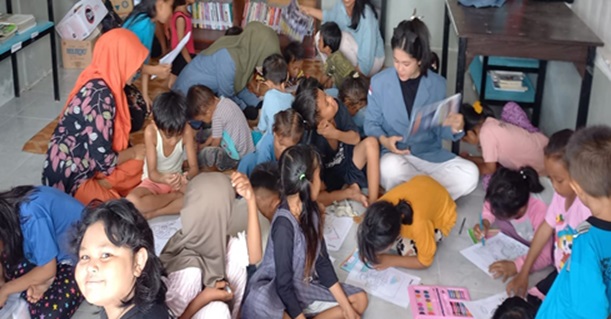Pelatihan Membaca sebagai Upaya Meningkatkan Literasi Anak Nelayan
Reading Training as an Effort to Literacy of Fisherman’s Children
DOI:
https://doi.org/10.33084/pengabdianmu.v10i1.8278Keywords:
Literacy, Reading, Fisherman’s ChildrenAbstract
Early childhood and elementary school reading training is essential in forming a literacy foundation for children. This training activity aims to improve children's reading literacy in Tanjung Pasir Tarakan Village, North Kalimantan. The training methods used are demonstration and training. The training activities are designed through creative and interactive activities to stimulate children in reading activities and help them understand their meaning. The stages of this training activity consist of the initial stage, the implementation stage, and the final stage. The initial stage is a form of planning before the reading training is carried out; the implementation stage is the process of reading training activities. Activities include demonstrations and direct practice of reading with media through picture stories, letter recognition, and short stories. The final stage is to monitor and evaluate the implementation of the activities that have been carried out. The results of the implementation of this activity show that the fishermen's children are very enthusiastic about participating in the reading training. Children show a significant increase in interest in reading activities; children can already recognize letters, their vocabulary increases, they can read simple words, and they can already read short stories (for lower-grade children). This training shows the good impact of this reading training program on children's reading abilities. This training is an early milestone for the development of children's literacy.
Downloads
References
Bahşi, N., & Ateş, A. (2024). International Journal of Education & Literacy Studies The Correlation Between Eighth-Grade Students Metacognitive Reading Awareness, Reading Intrinsic Motivation, and Reading Habits ARTICLE INFO. The Correlation Between Eighth-Grade Students Metacognitive Reading Awareness, Reading Intrinsic Motivation, and Reading Habits, 12(2), 19. http://dx.doi.org/10.7575/aiac.ijels.v.12n.2p.12www.ijels.aiac.org.au
Bazarbayeva, Z. M., Amanbayeva, A. Z., Zhumabayeva, Z. T., & Zhalalova, A. M. (2021). The Pragmalinguistic Character of Intonation Units in Discourse. Journal of Language and Linguistic Studies, 17(4), 2081–2095. https://doi.org/10.52462/jlls.150
Khadijah, Pulungan, E. N., Hariati, R., & Maisarah. (2022). Developing the Educational Game Tool to Improve Reading Ability of Early Childhood. International Journal of Language Education, 6(1), 25–35. https://doi.org/10.26858/ijole.v6i1.20145
Mardiah, dkk. (2021). Pelatihan Membaca Puisi Sesuai dengan Kaidah Bahasa Indonesia bagi Siswa Madrasah. ABDIMASY: Jurnal Pengabdian Dan Pemberdayaan Masyarakat, 2(1), 25–35. https://ejournal.stai-tbh.ac.id/index.php/abdimasy/article/download/521/328
Nie, B., Deacon, H., Fyshe, A., & Epp, C. D. (2022). Predicting Reading Comprehension Scores of Elementary School Students. Proceedings of the 15th International Conference on Educational Data Mining, EDM 2022, July. https://doi.org/10.5281/zenodo.6852952
Piasta, S. B., Groom, L. J., Khan, K. S., Skibbe, L. E., & Bowles, R. P. (2018). Young Children’s Narrative Skill: Concurrent and Predictive Associations with Word Reading Skills. Reading and Writing, 31(7), 1479–1498. https://doi.org/10.1007/s11145-018-9844-7
Ratminingsih, N. M., Budasi, I. G., & Kurnia, W. D. A. (2020). Local culture-based storybook and its effect on reading competence. International Journal of Instruction, 13(2), 253–268. https://doi.org/10.29333/iji.2020.13218a
Sari, D. K., Dewanti, S. S. H., & Tasu’ah, N. (2017). Application of Media Booklet to Improve Language Development (initial reading) on Children in Kinder-garten Kemala Group B Bhayangkari 34 Kendal. Indonesian Journal of Early Child-Hood Education Studies, 6(2), 125–131. https://doi.org/10.15294/ijeces.v6i2.20242
Scarborough, H. S. (2001). Connecting early language and literacy to later reading (dis)abilities: Evidence, theory, and practice. In S. B. Neuman & D. K. Dickinson (Eds.), Handbook of early literacy research. New York: Guilford. https://johnbald.typepad.com/files/handbookearlylit.pdf
Teale, W., & Sulzby, E. (1986). Emergent Literacy: Writing and Reading. Norwood, NJ: Albex. https://eric.ed.gov/?id=ED280004
Triyanto. (2019). Understanding Student Participation within a Group Learning. South African Journal of Education, 39(2), 1–8. https://doi.org/10.15700/saje.v39n2a1629
Wijaya, S. A., Susilo, D. K., & Sari, D. S. R. (2021). Faktor Penyebab Kurangnya Minat Anak Keluarga Nelayan Melanjutkan Pendidikan ke Perguruan Tinggi di Desa Puger Kulon Kecamatan Puger. Jurnal Pendidikan Ekonomi Undiksha, 13(2), 422. https://doi.org/10.23887/jjpe.v13i2.42309
Wilson, K. J., Brickman, P., & Brame, C. J. (2018). Group work. CBE Life Sciences Education, 17(1). https://doi.org/10.1187/cbe.17-12-0258

Downloads
Published
How to Cite
Issue
Section
License
Copyright (c) 2025 Asih Riyanti, Nurul Hanna Fauziyyah

This work is licensed under a Creative Commons Attribution-ShareAlike 4.0 International License.
Authors who publish with this journal agree to the following terms:
- Any article on the copyright is retained by the author(s).
- Author grant the journal, right of first publication with the work simultaneously licensed under a Creative Commons Attribution License that allows others to share work with acknowledgment of the work authors and initial publications in this journal.
- Authors are able to enter into a separate, additional contractual arrangements for non-exclusive distribution of published articles of work (eg, post-institutional repository) or publish it in a book, with acknowledgment of its initial publication in this journal.
- Authors are permitted and encouraged to post their work online (e.g., in institutional repositories or on their websites) prior to and during the submission process, as can lead to productive exchanges, as well as earlier and greater citation of published work.
- The article and any associated published material is distributed under the Creative Commons Attribution-ShareAlike 4.0 International License










